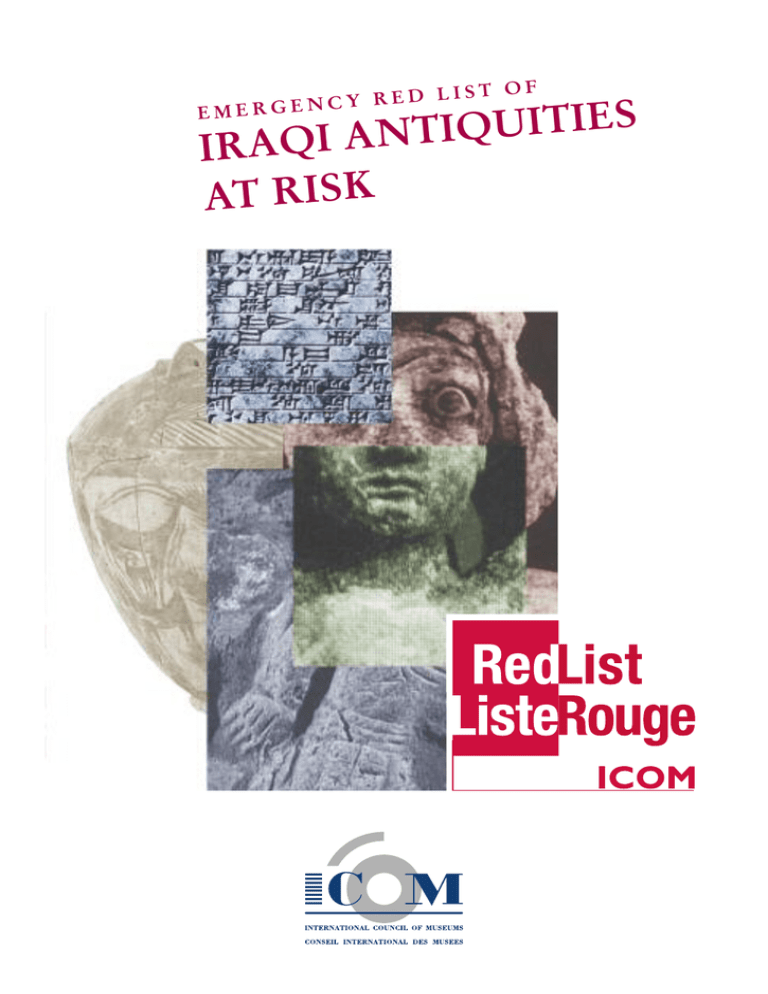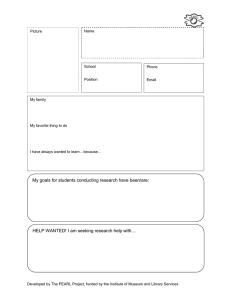
NC
EMERGE
ST OF
Y RED LI
S
E
I
T
I
U
Q
I
T
IRAQI AN
AT RISK
Y
C
N
E
G
R
EME
T
S
I
L
D
E
R
SK
UITIES
Q
I
T
N
A
I
OF IRAQ
AT R I
Suspicious characteristics
Any object with reference numbers written
on it and any object that shows traces of
reference numbers in ink. The inventory
numbers of the Iraq Museum generally
follow the mention “IM” (abbreviation for
“Iraq Museum”). [illus. 0]
Any object with cuneiform (“wedge-shaped”)
writing on it. This writing is composed of
horizontal, vertical or oblique strokes with
triangular ends, impressed or incised into
the material. Cuneiform looks like a lot of
small triangular depressions arranged in
patterns. Early examples look like picture
writing. It is found especially on objects of
clay and stone, but also metal, ivory, and
pottery. [illus. 1]
0
1
Any object with Aramaic writing on it
(alphabetic writing, mostly engraved or in ink).
[illus. 2]
0. ©Iraq Museum/Salvini
1. ©Iraq Museum
2. ©Musée du Louvre
This Red List was drawn up by a group of 12 international experts during a meeting
held at the Interpol headquarters in Lyons (France) on 7 May 2003.
© 2008, ICOM, all rights reserved.
2
Introduction
Purpose
Cultural heritage in Iraq has suffered
seriously as a result of war. Many objects
have been looted and stolen from museums
and archaeological sites and risk appearing
on the market through illicit trafficking.
This document has been designed as a tool
for customs officials, police officers, museums,
art dealers and collectors to help them to
recognize objects that could originate from
Iraq.
Although the Iraq Museum in Baghdad
is not the only place that has suffered, it is
certainly by far the most important
institution. The museum has been looted
and is missing a great part of its former
collection. The Iraq Museum is a national
archaeological museum that serves as the
repository for all artefacts from excavations
in Iraq. It contains hundreds of thousands
of objects covering 10,000 years of human
civilization, representing many different
cultures and styles. The bulk of the
collection dates between 8000 B.C. and
1800 A.D., and comprises objects made of
clay, stone, pottery, metal, bone, ivory,
cloth, paper, glass, and wood.
This Red List describes the general types
of artefacts most favoured by the illegal
antiquities market, so that these may be
identified and detained wherever they
surface. They are protected by legislation,
banned from export and may under no
circumstances be imported or put on sale.
An appeal is therefore being made to
museums, auction houses, art dealers and
collectors not to acquire them.
This is a list of the types of objects from
Iraq which are particularly at risk and are
likely to have been stolen. It is in no way
exhaustive. Because of the tremendous variety
of objects, styles, and periods, any antiquity
from Iraq should be treated with suspicion.
Iraqi cultural heritage is protected under:
- Law Prohibiting the Smuggling of Antiquities No. 40 of 1926
- Antiquities Law No. 59 of 1936 and the two Amendments (No. 120 of 1974 and No. 164 of 1975)
- Law No. 6 of 1942: Regulations regarding the Registration of Old Manuscripts
- Antiquities and Heritage Law No. 55 of 2002
On 21.03.1968, Iraq ratified the 1954 Hague Convention for the Protection of Cultural Property
in the Event of Armed Conflict, and its First Protocol.
On 12.05.1973, Iraq ratified the 1970 UNESCO Convention on the Means of Prohibiting and Preventing
the Illicit Import, Export and Transfer of Ownership of Cultural Property.
EMERGENCY
RED
LIST
OF
IR
T H E R E D L I S T I N C LU D E S T H E F O L LO W I N G C AT E G O R I E S O F O B J E C T S :
(These images serve to illustrate the categories of objects which are the target of illicit traffic.)
Tablets of clay or stone
with cuneiform writing.
Most common are pillow-shaped clay tablets (one side rounded,
the other side flat), square or rectangular, sometimes round.
They typically range from 4 x 5 cm to 20 x 30 cm in size. They
sometimes have a casing (often fragmentary) sealed. They are
usually sun-dried and must be handled with extreme care. If not
stored under controlled humidity, they may disintegrate
(optimum relative humidity: 45-50%). For identification, they
should be photographed under raking light coming from the
upper left. [illus. 3, 4]
3
4
3. Clay proto-cuneiform tablet with early pictographic writing,
end of the 4th millennium B.C. ©British Museum
4. Clay cuneiform tablet, still partly in its envelope,
beginning of the 2nd millennium B.C. ©Musée du Louvre
Cones and any other objects
(bricks, prisms, vases, sculpture, etc.)
with cuneiform writing.
Most common are clay cones roughly 15 cm long with a flattened
head (disk-shaped). [illus. 5]
5
Cylinder seals of stone, shell, frit, etc.
These look like large cylindrical beads with pictures engraved on
them, and often a cuneiform inscription. They range in length
from 2 to 7 cm, and in diameter from 1 to 3 cm. [illus. 6]
6
5. Baked clay foundation cone with cuneiform writing,
end of the 3rd millennium B.C. ©Musée du Louvre
6. Stone cylinder seal, beginning of the 2nd millennium B.C.,
Musée du Louvre. ©RMN/Franck Raux
Stamp seals of stone, shell, etc.,
and their impressions.
Stamp seals are small lumps of stone, often animal or gem- 7
shaped (about 3 or 4 cm), with pictures carved on one side
7. Stone stamp seals, Jamdat Naser period, about 3000 B.C.,
(about 1.5 to 3 cm). Impressions are lumps of clay with small
Iraq Museum. ©photo Scala, Florence
pictures from cylinder seals or stamp seals impressed in them.
7bis. Stone stamp seals in the shape of animals
[illus. 7, 7bis]
and their impression, about 3000 B.C. ©Musée du Louvre
7bis
RAQI
ANTIQUITIES
AT
RISK
Ivory, bone plaques and sculptures.
8. Ivory plaque from Nimrud,
9th-8th centuries B.C. (stolen).
©Iraq Museum
Any object made of ivory that looks old. Most common are
small flat plaques (8 to 20 cm) carved with figures or
ornament, originally used as furniture inlays. Many look
Egyptian. [illus. 8]
8
Sculpture, 3-dimensional and relief.
9
A. Stone, dark or white. The most common types of figures are:
• Standing figurines in white stone (or marble), about 10 to
15 cm high. [illus. 9]
• Under-life-size standing or seated figures with folded hands,
ranging from about 15 to 60 cm high (sometimes life size).
[illus. 10, 10bis]
• Figures in provincial or oriental Roman style from Hatra,
especially heads. [illus. 11]
B. Clay. Small figures, usually unbaked. The most common
types are:
10
• Human and animal figurines, often crudely made (about 8
to 15 cm high). [illus. 12]
• Models and "toys" of beds, boats, chariots, houses, etc.
(about 10 to 20 cm high, sometimes more for the houses).
[illus. 13]
• Mould-made plaques, often naturalistic, representing scenes
from daily life and scenes of worship (about 8 to 15 cm high).
[illus. 14]
10bis
11
C. Bronze figurines (often oxidized). One common type has
the lower body in the shape of a peg (about 12 to 20 cm high).
[illus. 15]
12
9. Stone figurines from Tell es-Sawwan, beginning
of the 6th millennium B.C. ©Iraq Museum
10. Stone Sumerian statue, about 2400 B.C. ©Iraq Museum
10bis. Sumerian alabaster statue from Ur, about 2400 B.C.,
Iraq Museum. ©photo Scala, Florence
11. Stone statue from Hatra, 2nd century A.D., Iraq Museum.
©photo Scala, Florence
13
12. Terra cotta Sumerian figure from Tello, about 2000 B.C., Iraq Museum. ©photo Scala, Florence
13. Clay chariot model, beginning of the 2nd millennium B.C., Musée du Louvre. ©RMN/Lewandowski/Raux
14. Terra cotta relief: cult scene from Khafaji, about 1800 B.C., Iraq Museum. ©photo Scala, Florence
15. Bronze foundation figurine, end of the 3rd millennium B.C., Iraq Museum. ©photo Scala, Florence
14
15
EMERGENCY
RED
LIST
OF
IR
D. Stone plaques and slabs, often in fragments, carved in relief.
[illus. 16, 17]
16. Stone Assyrian relief fragment from Nineveh,
about 700 B.C. (stolen). ©J. Russell
17. Panel carved in relief: Assyrian warriors from Khorsabad,
end of the 8th century B.C., Iraq Museum. ©photo Scala, Florence 16
Vessels/Containers, large or small.
17
A. Pottery/Ceramics, often broken or incomplete. There is a
tremendous variety of decoration: plain, painted, inscribed,
decorated and/or glazed. [illus. 18, 19]
B. Glass. Old glass often has a shiny metallic iridescent sheen.
It is often decorated with wavy patterns. [illus. 20, 20bis]
19
18
20
20bis
18. Pottery jar decorated “scarlet ware” from Khafaji, beginning
of the 3rd millennium B.C., Iraq Museum. ©photo Scala, Florence
19. Islamic monochrome lustre ware cup, 10th century A.D.
©Musée du Louvre
20. Glass bottles from Nimrud, 3rd-7th centuries A.D. ©British Museum
20bis. Cup, 13th century A.D. ©Iraq Museum
C. Metal (bronze, silver, gold), plain or decorated. [illus. 21]
D. Stone, sometimes carved in relief or inlaid. One type is made
of marble or alabaster and is quite small (miniature vases).
[illus. 22]
21
Jewellery, carved gems
and personal adornments:
gold, silver, bronze, shell, stone, etc.
Inlays and multicoloured stones are commonly used (predominantly lapis lazuli, carnelian, agate, rock crystal and turquoise).
[illus. 23]
23
21. Gold bowl, Royal Cemetery of Ur, about 2500 B.C. ©University
of Pennsylvania Museum of Archaeology and Anthropology
22. Small alabaster vessels, Tell es-Sawwan, 6th millennium B.C.
©Iraq Museum
22
23. Jewellery board, Royal Cemetery of Ur, about 2500 B.C.
©Iraq Museum
RAQI
ANTIQUITIES
AT
RISK
Manuscripts, calligraphy, books
and archival documents.
[illus. 24]
24
Architectural and furniture fragments:
plaster, wall painting, tiles,
decorated bricks, wood.
Islamic examples are often decorated with intricate patterns
that may include Arabic script. [illus. 25, 26]
24. Islamic manuscript page in Arabic.
©Iraq Museum Library/Tabbaa
25. Islamic carved brick architectural decoration.
©Iraq Museum/Tabbaa
26. Islamic wooden panel. ©Iraq Museum
25
26
27. Islamic coins. ©Iraq Museum
Coins.
Antique coins are hand stamped, so the subject is often
off-centre. Pre-Islamic coins usually include pictures. Islamic
examples are decorated only with Arabic script, which often
identifies the place of production. [illus. 27]
27
The International Council of Museums (ICOM) is the principal
international organization of museums and museum professionals
committed to the conservation, continuation and communication
to society of the world’s natural and cultural heritage, present
and future, tangible and intangible.
With over 24,000 members in 147 countries, ICOM is an international network of museum professionals expert in a wide variety
of disciplines.
Created in 1946, ICOM is a not-for-profit non-governmental
organization (NGO) maintaining formal relations with UNESCO
and having a consultative status with the United Nations’
Economic and Social Council.
The fight against illicit traffic of cultural goods is one of ICOM’s
core commitments. The Emergency Red List of Iraqi Antiquities at
Risk has been compiled to prevent cultural objects being sold
illegally on the art market, and thus to ensure the protection of
Iraqi heritage. To date, ICOM has published Red Lists for Africa,
Latin America, Iraq, Afghanistan and Peru.
http://icom.museum/redlist
This Red List was developed with the generous support of:
Maison de l’UNESCO
1, rue Miollis - 75732 Paris Cedex 15 - France
Telephone: +33 (0)1 47 34 05 00 - Fax: +33 (0)1 43 06 78 62
Email: secretariat@icom.museum - Website: http://icom.museum
9/08 - TAM TAM TEAM
U.S. Department of State
Bureau of Educational and Cultural Affairs


